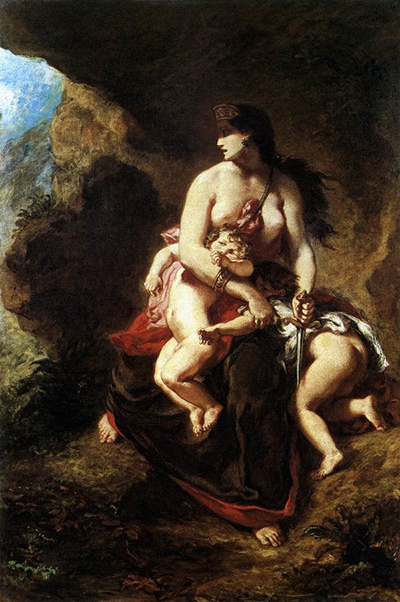Delacroix painted Medea in 1838, and it was exhibited to great acclaim at the Salon that year.
The savagery of the subject is equalled by the dramatic quality of the painting, reminding some of the work of Caravaggio.
In the Greek myth, when Jason is unfaithful to Media, she first kills his new wife, and then murders Jason's (and her own) children in revenge.
Delacroix shows her the moment before she commits the murder; the dagger is in her hand, and the viewer knows that she will use it.
Delacroix has set the scene in a cave, with raking light throwing the figures into chiaroscuro to increase the intensity of the emotional effect.
Media and her two children form a pyramidal massing that would have been typical of neo-classical art, but they seem almost to merge into each other; perhaps there's a little wry reference to the figure of the Virgin and the dead Christ of the Pieta, as well.
A closer look shows the children are wriggling, trying to get away; Delacroix racks up the horror of the scene.
Tellingly, the pink naked flesh and white drapes of the children contrast with the dark red and brown of Medea's robe, suggesting both white as the colour of innocence, and the vulnerability of nakedness.
Her robe is almost blood-coloured, with obvious symbolic value, and her face, intriguingly, is half in shadow, almost as if she is wearing a mask.
The dagger is a tiny streak of highlight in the darkness of the cave. The viewer's eyes can't help being drawn to it, and to the insistent vertical of Medea's left arm, which holds it. It seems to focus the entire painting.
But Medea, instead, is looking out of the cave, up at a tiny glimpse of pastel blue sky, a unique colour accent in this painting.
Delacroix suggests that the brightness and beauty of the outside world is something she's seeing for the very last time.
Is the painting melodramatic? Delacroix himself said "I dislike reasonable painting", and with this femme fatale he created an emotionally intense scene of real horror.




